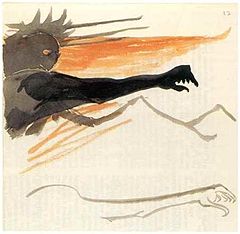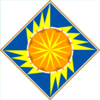
Arwen Undómiel is a fictional character in J. R. R. Tolkien's Middle-earth legendarium. She appears in the novel The Lord of the Rings. Arwen is one of the half-elven who lived during the Third Age; her father was Elrond half-elven, lord of the Elvish sanctuary of Rivendell, while her mother was the Elf Celebrian, daughter of the Elf-queen Galadriel, ruler of Lothlórien. She marries the Man Aragorn, who becomes King of Arnor and Gondor.
Eärendil the Mariner and his wife Elwing are characters in J. R. R. Tolkien's Middle-earth legendarium. They are depicted in The Silmarillion as Half-elven, the children of Men and Elves. He is a great seafarer who, on his brow, carried the Morning Star, a jewel called a Silmaril, across the sky. The jewel had been saved by Elwing from the destruction of the Havens of Sirion. The Morning Star and the Silmarils are elements of the symbolism of light, for divine creativity, continually splintered as history progresses. Tolkien took Eärendil's name from the Old English name Earendel, found in the poem Crist A, which hailed him as "brightest of angels"; this was the beginning of Tolkien's Middle-earth mythology. Elwing is the granddaughter of Lúthien and Beren, and is descended from Melian the Maia. Through their progeny, Eärendil and Elwing became the ancestors of the Númenorean, and later Dúnedain, royal bloodline.
Glorfindel is a fictional character in J. R. R. Tolkien's Middle-earth legendarium. He is a member of the Noldor, one of the three groups of the Calaquendi or High Elves. The character and his name, which means "blond" or "golden-haired", were among the first created for what would become part of his Middle-earth legendarium in 1916–17, beginning with the initial draft of The Fall of Gondolin. His name indicates his hair as a mark of his distinction, as the Noldor were generally dark-haired. A character of the same name appears in the first book of The Lord of the Rings, The Fellowship of the Ring, which takes place in Middle-earth's Third Age. Within the story, he is depicted as a powerful Elf-lord who could withstand the Nazgûl, wraith-like servants of Sauron, and holds his own against some of them single-handedly. Glorfindel and a version of the story of the Fall of Gondolin appear in The Silmarillion, posthumously published in 1977.
A Balrog is a powerful demonic monster in J. R. R. Tolkien's Middle-earth. One first appeared in print in his high-fantasy novel The Lord of the Rings, where the Fellowship of the Ring encounter a Balrog known as Durin's Bane in the Mines of Moria. Balrogs appear also in Tolkien's The Silmarillion and his legendarium. Balrogs are tall and menacing beings who can shroud themselves in fire, darkness, and shadow. They are armed with fiery whips "of many thongs", and occasionally use long swords.
In J. R. R. Tolkien's fictional legendarium, Beleriand was a region in northwestern Middle-earth during the First Age. Events in Beleriand are described chiefly in his work The Silmarillion, which tells the story of the early ages of Middle-earth in a style similar to the epic hero tales of Nordic literature, with a pervasive sense of doom over the character's actions. Beleriand also appears in the works The Book of Lost Tales, The Children of Húrin, and in the epic poems of The Lays of Beleriand.
Gil-galad is a fictional character in J. R. R. Tolkien's Middle-earth legendarium, the last high king of the Noldor, one of the main divisions of Elves. He is mentioned in The Lord of the Rings, where the hobbit Sam Gamgee recites a fragment of a poem about him, and The Silmarillion. In the Last Alliance of Elves and Men, Gil-galad and Elendil laid siege to the Dark Lord Sauron's fortress of Barad-dûr, and fought him hand-to-hand for the One Ring. Both Gil-galad and Elendil were killed, and Elendil's son Isildur took the Ring for himself. Gil-galad briefly appears at the opening of Peter Jackson's The Lord of the Rings film trilogy, and features in several video games based on Tolkien's Middle-earth.
In J.R.R. Tolkien's legendarium, Gondolin is a secret city of Elves in the First Age of Middle-earth, and the greatest of their cities in Beleriand. The story of the Fall of Gondolin tells of the arrival there of Tuor, a prince of Men; of the betrayal of the city to the dark Lord Morgoth by the king's nephew, Maeglin; and of its subsequent siege and catastrophic destruction by Morgoth's armies. It also relates the flight of the fugitives to the Havens of Sirion, the wedding of Tuor and the Elf Idril, and the childhood of their son Eärendil.
In J. R. R. Tolkien's Middle-earth, the Eagles or Great Eagles, are immense birds that are sapient and can speak. The Great Eagles resemble actual eagles, but are much larger. Thorondor is said to have been the greatest of all birds, with a wingspan of 30 fathoms. Elsewhere, the Eagles have varied in nature and size both within Tolkien's writings and in later adaptations.
Magic in Middle-earth is the use of supernatural power in J. R. R. Tolkien's fictional Middle-earth. Tolkien distinguishes ordinary magic from witchcraft, the latter always deceptive, stating that either type could be used for good or evil.
The cosmology of J. R. R. Tolkien's legendarium combines aspects of Christian theology and metaphysics with pre-modern cosmological concepts in the flat Earth paradigm, along with the modern spherical Earth view of the Solar System.
The Maiar are a fictional class of beings from J. R. R. Tolkien's high fantasy legendarium. Supernatural and angelic, they are "lesser Ainur" who entered the cosmos of Eä in the beginning of time. The name Maiar is in the Quenya tongue from the Elvish root maya- "excellent, admirable".
Legolas is a fictional character in J. R. R. Tolkien's The Lord of the Rings. He is a Sindar Elf of the Woodland Realm and son of its king, Thranduil, becoming one of the nine members of the Fellowship who set out to destroy the One Ring. Though Dwarves and Elves are traditionally rivals, he and the Dwarf Gimli form a close friendship during their travels together.

Sauron is the title character and the primary antagonist, through the forging of the One Ring, of J. R. R. Tolkien's The Lord of the Rings, where he rules the land of Mordor and has the ambition of ruling the whole of Middle-earth. In the same work, he is identified as the "Necromancer" of Tolkien's earlier novel The Hobbit. The Silmarillion describes him as the chief lieutenant of the first Dark Lord, Morgoth. Tolkien noted that the Ainur, the "angelic" powers of his constructed myth, "were capable of many degrees of error and failing", but by far the worst was "the absolute Satanic rebellion and evil of Morgoth and his satellite Sauron". Sauron appears most often as "the Eye", as if disembodied.

Forests appear repeatedly in J. R. R. Tolkien's fantasy world of Middle-earth. In The Hobbit, Bilbo Baggins and party have adventures in the Trollshaws and in Mirkwood. In The Lord of the Rings, Frodo Baggins and his companions travel through woods in The Shire, and are pursued by Black Riders; to evade them, the party enters the feared Old Forest, where they encounter other hazards. Later the Fellowship comes to the Elvish forest realm of Lothlórien; and after the Fellowship has split up, Frodo and Sam Gamgee travel through Ithilien with its Mediterranean vegetation, while Merry Brandybuck and Pippin Took enter the ancient forest of Fangorn. The Riders of Rohan, on their way to war, are allowed to travel on a secret road through another ancient forest, that of the Drúedain or woses. The Silmarillion, too, features several forests, both in Beleriand which is home to places like the Elvish forest realm of Doriath, protected by the magic of Melian the Maia, and in the south of Valinor, where the Valar liked to hunt in the woods of Oromë.

The naming of weapons in Middle-earth is the giving of names to swords and other powerful weapons in J. R. R. Tolkien's legendarium. He derived the naming of weapons from his knowledge of Medieval times; the practice is found in Norse mythology and in the Old English poem Beowulf. Among the many weapons named by Tolkien are Orcrist and Glamdring in The Hobbit, and Narsil / Andúril in The Lord of the Rings. Such weapons carry powerful symbolism, embodying the identity and ancestry of their owners.
Tolkien's Middle-earth family trees contribute to the impression of depth and realism in the stories set in his fantasy world by showing that each character is rooted in history with a rich network of relationships. J. R. R. Tolkien included multiple family trees in both The Lord of the Rings and The Silmarillion; they are variously for Elves, Dwarves, Hobbits, and Men.
Tolkien's monsters are the evil beings, such as Orcs, Trolls, and giant spiders, who oppose and sometimes fight the protagonists in J. R. R. Tolkien's Middle-earth legendarium. Tolkien was an expert on Old English, especially Beowulf, and several of his monsters share aspects of the Beowulf monsters; his Trolls have been likened to Grendel, the Orcs' name harks back to the poem's orcneas, and the dragon Smaug has multiple attributes of the Beowulf dragon. The European medieval tradition of monsters makes them either humanoid but distorted, or like wild beasts, but very large and malevolent; Tolkien follows both traditions, with monsters like Orcs of the first kind and Wargs of the second. Some scholars add Tolkien's immensely powerful Dark Lords Morgoth and Sauron to the list, as monstrous enemies in spirit as well as in body. Scholars have noted that the monsters' evil nature reflects Tolkien's Roman Catholicism, a religion which has a clear conception of good and evil.

J. R. R. Tolkien was attracted to medieval literature, and made use of it in his writings, both in his poetry, which contained numerous pastiches of medieval verse, and in his Middle-earth novels where he embodied a wide range of medieval concepts.

J. R. R. Tolkien, a devout Roman Catholic, created what he came to feel was a dilemma for himself with his supposedly evil Middle-earth peoples like Orcs, when he made them able to speak, so they were sentient and sapient, and portrayed them talking about right and wrong. This meant, he believed, that they were open to morality, like Men. In Tolkien's Christian framework, that in turn meant they must have souls, so killing them would be wrong without very good reason. Orcs serve as the principal forces of the enemy in The Lord of the Rings, where they are slaughtered in large numbers in the battles of Helm's Deep and the Pelennor Fields in particular.





































